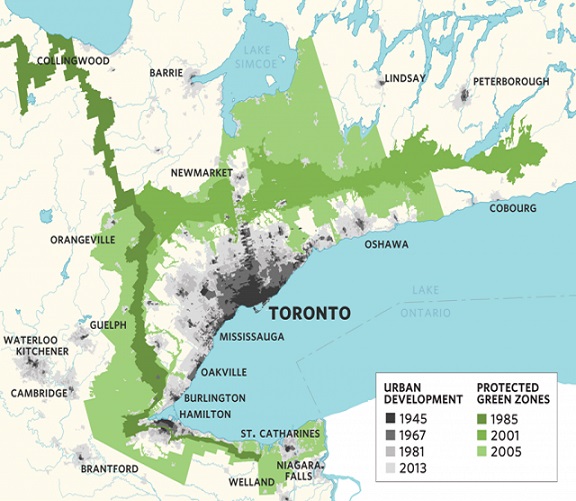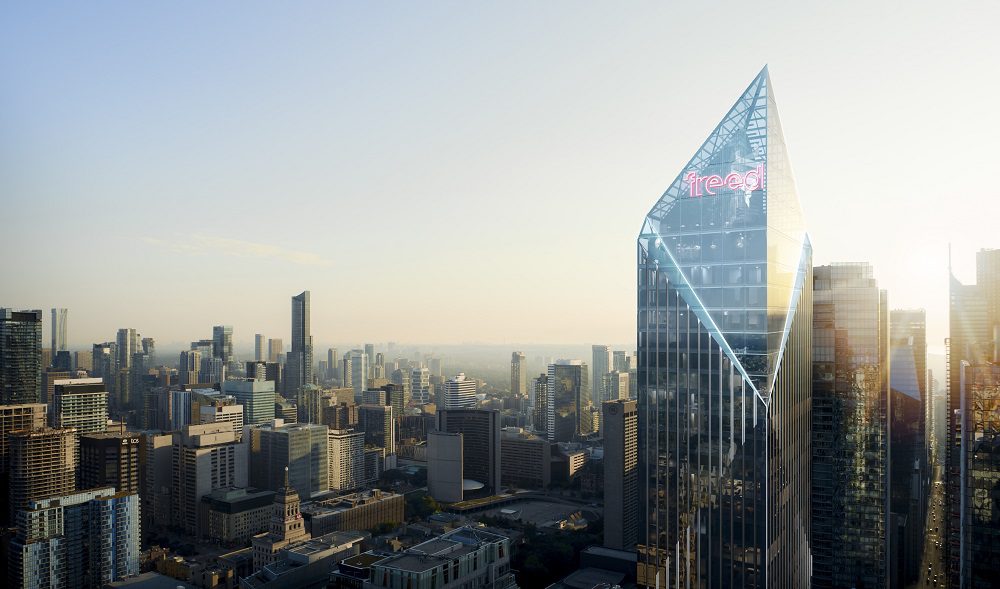Just the mere suggestion will have half the residents of the GTA at my throat.
But something has to give, while the government is looking up, down, and backwards at ways they can help cool the Canadian housing market, there’s one thing that never gets discussed, and that’s how to increase supply, rather than simply decreasing demand.
We often forget about the “supply” in the supply/demand equation. But perhaps it’s time we revisit the idea?

I didn’t cover the latest round of changes from the Canadian Finance Minister on my blog.
I don’t know why. Maybe it’s because it was covered by every single outlet, all last week?
My Facebook feed last week had three topics:
1) Donald Trump vs. Hilary Clinton
2) Mortgage rule changes in Canada
3) Cute puppies
Facebook never changes, does it?
But all day, every day, all we heard about were these mortgage changes.
And there’s likely more to come.
I believe that this week or next, John Tory, or Kathleen Wynne, will announce some sort of foreign buyer’s tax in Toronto or the GTA to match that of the Vancouver government from this past summer.
I’ve said in past blog posts that nothing the government has ever done has affected the real estate market.
They’ve made massive changes in the past, and the market continued to rise!
Remember 107% financing?
Remember 40-year amortizations?
Remember buying a primary residence with 0% down, or investment properties with 5% down?
Yeah, those juicy features are long gone.
CMHC insurance has been raised, minimum down payments have been raised, and countless policies have been enacted to try and cool the real estate market, and yet nothing has had an effect here in Toronto.
So last week, the government gave us another round of revisions.
They’re going to “close a tax loophole” that isn’t really a loophole.
There are LAWS, and those laws aren’t being enforced.
So to say there’s a “loophole” let’s our government off the hook for not doing their job.
They’re going to “revisit and potentially limit the risk to Canadians” by reconsidering how much mortgage insurance CMHC will take on.
That’s great news for Genworth and Canada Guaranty, is it not?
But the one change they’re making that does have significance is the mortgage stress test, which might take the bottom-buyers out of the market.
The little guy gets screwed, again!
It’s classic government action, after inaction, is it not?
While foreign buyers gobble up more and more of the country, the government sits idly by, and then eventually pops in, and makes it impossible for the buyers at the very bottom of the market to buy.
So while the 23-year-old who has saved from every summer job for eight years, and the late-20’s couple who have been planning to buy for three years, are no longer able to purchase, the holding company with overseas principals can continue to buy acres of land north of Toronto and hold them for the next fifty years.
True story.
We’ve heard the anecdotal stories of the neighbourhoods in Vancouver that used to be home to kids riding their bikes up and down the streets, while lemonade stands adorn the front lawns, that are now completely empty, as foreign buyers have bought up all the homes.
But I know people north of Toronto who have seen all the farm lands gobbled up by holding companies, with suspicions about these companies’ origins proving correct.
So before I stray into a fifth and sixth direction with this blog post, let me get to the crux of the matter.
If the Canadian government wants to:
a) cool the real estate market
b) make it affordable for Canadians
There is only one thing that can be done.
Justin Trudeau needs to stand in front of a podium, and announce that from this day forward, only Canadian residents may own Canadian real estate.
And since we know that day is never going to happen (I don’t even think Stephen Harper would have done that), we Canadians have to accept that the dream of owning our own home may never become a reality, and that the government’s response will always be reactive, short-term, and knee-jerk in nature, and unfair to one more segments of the population.
Everybody has come out of the woodwork in the past week with their thoughts, and their ideas, about how to solve our housing “crisis” or what to do, or not do.
Most of what you read either makes you sigh with disgust, as it’s just so biased and/or false, or it makes you silently cheer as you mutter “I’m glad somebody finally said it.”
This might not be Clinton vs. Trump, but we’re all having our own little internal debates about what to do about Canadian home prices.
So let me add my two cents to the mix.
In any market that is extremely hot or extremely cold, the cause always traces back to supply and demand.
Too much supply, too little supply, too much demand, or too little demand. Or a combination.
What we’re seeing in the Toronto market is both too little supply, and too much demand, which is a recipe for disaster.
The government’s idea, since they started “trying to cool the housing market” after the U.S.’ housing crisis in 2008-09, has always revolved around reducing demand.
The government is always trying to eliminate demand, by making it harder for interested buyers to purchase.
All of the policy changes they’ve enacted have done so, or tried to make it harder to purchase.
But what about the other side of the equation?
What about supply?
Why isn’t the government looking at ways to rapidly increase the supply of housing, thereby restoring equilibrium to the supply/demand equation?
I have always thought that Golden Horseshoe Greenbelt was a fantastic idea in theory, but one that would eventually become troublesome.
Our population is growing. Rapidly.
And as Canada adds more than 250,000 immigrants per year, many of them are going to see Toronto as the most attractive location.
Toronto is the 4th largest metropolitan area in North America, and it’s getting bigger, and bigger.
Our infrastructure will never catch up with growth, as our inept city councilors continue to debate whether a hot dog tastes better with ketchup or mustard, when we need subways, railways, roads, bridges, tunnels, schools, and parks – like we did last year, and the year before, and the year before…
But that’s a topic for another day.
The city is growing at an unsustainable rate, based on the supply of housing.
And unless Justin Trudeau stands in front of that microphone and “pulls an Australia,” then we need more housing. Period.
So where is the one place we know of, near the GTA, where there’s masses and masses of land available on which to build?
The Greenbelt.
Many of you won’t love this idea.
The Greenbelt is there for a reason. It gives us air to breathe, water to drink, a place for wildlife to run free, and it’s really, really pretty.
But our population is growing.
Our housing supply is being gobbled up by non-residents, who want to hold it, and keep it empty.
Prices are skyrocketing, and will continue to do so.
We need more housing, and there’s nowhere to build.
So unless Toronto city council is going to start allowing 100-storey towers next door to 8-storey buildings (which they probably would – they love that tax revenue!), then we need to find somewhere to build actual houses, and at the same time, stop our city from becoming so dense, we can’t see through it.
There are 7,300 square kilometers in the Greenbelt.
I’m not suggesting we shoot every bird, and cut down every tree, throughout the entire Greenbelt.
But in lieu of government intervention in other areas (as noted above…) I think starting a discussion about what parts of the Greenbelt could be opened up to development is a reasonable, rational, responsible idea.
If we don’t have that discussion today, we’ll have it tomorrow.
And if we don’t have it tomorrow, we’ll have it the day after.
You get the idea.
Lots more to say on this, but I’ve been sick with the flu all weekend.
My Thanksgiving dinner consisted of soup and Gatorade!
This was the best I could muster up with the clouds in my head, but perhaps we’ll continue the discussion on Wednesday, and I have no doubts that you’ll continue the discussion below…































Francesca
at 7:15 am
First of all sorry you spent your long holiday weekend sick. Hope you get better soon David.
I live in Markham on the eastern end of the city that confines with Pickering and basically farmland north, south and east of me. We are very close to where the proposed Pickering airport could be built. We’ve lived here for almost 8 years and have seen hundreds of houses built every year. Unfortunately the house prices have doubled in the time we’ve been here. Great for us if we wanted to cash out and sell but not so great for new families wanting to move into the area. Pre-construction detached houses and re sale are selling well over a million dollars and a semi will cost you in the 700s and a townhouse in the 500s easily. It is no longer affordable for young families or immigrant families to buy here either and we are as close to the Greenbelt as you can possibly get. With the way immigration is going I wouldn’t be surprised at all if builders were given permission to buy up farmland and start building. In fact a beautiful farm that existed in Unionville at Kennedy and 16th got bought out for 10 million dollars I believe a few years ago and and is now all houses. A lot of the long term residents were up in arms when this happened but it was inevitable unfortunately. I agree with you David that we need the farmland for food, clean air and just beauty but things will only get worse for real estate here if rules don’t change to a certain degree. My main concern is again that it’s not as affordable as it could and should be because here too we have lots of foreign investors buying into the market. Also the more we build the worst traffic and commute times will get if we don’t improve and increase mass transportation that actually works. Unless people start working from home or finding jobs locally closer to their homes and neighbourhoods our traffic problems and frustrations in the GTA will only magnify. Vaughan will finally have a subway line soon and all of york region needs daily, ongoing Go Train service not just rush hour service to help people live in the suburbs and commute into the city if necessary.
RT82
at 9:04 am
I’m sorry I used to think the blog offered some interesting insight that wasn’t overly biased.
I think I’m done after reading this.
Ralph Cramdown
at 7:35 am
Meanwhile, in Forest Hill, residents are HORRIFIED that somebody wants to put up a 9 storey condo two blocks from the subway.
All of the great world cities that people compare Toronto to have higher population densities per square kilometer, better public transit and much larger economic output. Coincidence? Start paving over the greenbelt and building 24 townhouses per acre, and the “world class” cities we’ll be comparing ourselves to will be Atlanta and Dallas-Fort Worth. A city that is seriously contemplating building (and I’m not making this up) a one stop subway extension is a city that’s going nowhere fast.
Kyle
at 9:13 am
I agree that Supply needs to be looked at in the affordability conversation, but i don’t think further sprawl into the green belt is the answer. Not all supply is created equally. Building sparse tracts of housing and incomplete neighbourhoods (i.e. lacking transit, shopping, schools, parks and community services) in the green belt, does little to relieve the supply situation. If you look at housing around the GTA not every neighbourhood is “unaffordable”, in fact there are many within the 416 that are priced well below the average prices. The big differentiator in terms of pricing from one area to another is how complete the neighbourhood is. IMO i’d prefer the Government work on completing some of these neighbourhoods (e.g. adding transit, loosening up zoning to allow more mixed uses, building more community centers, etc) as opposed to releasing more land from the greenbelt.
Joe Q.
at 10:36 am
I agree with Kyle that continuing to expand with our current “sprawl” approach is not the answer, as it will just magnify the problems we already have with commute times, traffic, pollution, etc.
Meaningful expansion of public transit (regional rail, subway, LRT, BRT — whichever is most appropriate) is really the key to making the suburbs “work” better, and like Kyle, I think we can do more with what we have. Unfortunately, this will require painful sacrifices: increased taxes or levies, increased density, lengthy and disruptive construction projects, and restricted road space (to make room for transit-priority traffic), and it’s not at all clear that governments or the citizenry are willing to make these sacrifices.
Ralph Cramdown
at 11:30 am
The implicit sacrifice that many people are making is having their time spent in traffic double every ten(?) years. If you can’t walk, bicycle or take the subway to work, getting around is often a world of pain. But it’s getting worse so slowly as to be almost imperceptible, so taxpayers don’t want to bear the costs of doing something about it.
Joel
at 4:14 pm
Changing the zoning regulations and allowing for 4-5 story buildings on top of commercial in many areas of Toronto would really help fill in the supply issue. Adding parks and community centers will help make areas much more attractive. Look at the great work the City has done with Moss Park.
Kyle
at 4:58 pm
I think this is really the key. We are a big City stuck with small town housing forms, and a lot of people are very resistant to changing the housing forms. Mid-rise, mixed use buildings would allow this City to easily accommodate way more people (families included) without the accompanying long commutes.
Unfortunately every mid-rise project gets met with NIMBYs, who say the project cheapens their neighbourhood, like these people:
http://www.cbc.ca/news/trending/wealthy-toronto-residents-don-t-want-neighbours-with-sub-million-dollar-condos-1.3087974
or NIMBYs that say the project is over-gentrifying the neighbourhood and forcing people out.
natrx
at 9:41 am
It’s like expanding a highway. People think more highways and lanes is the answer, but all that does is attract more users and the end result is the same congestion. It’s about time immigrants started expanding into other Canadian Cities. I’m sure NY City, got over bloated and therefore, people decided to immigrate elsewhere resulting in a more balanced economic and ‘living’ nation. Canada must do the same.
As for the new rules, well, those first time home buyers are the ones buying 750-800K ‘slanty’ semis or 700k bungalows (yes, older minorities in Scarborough are overbidding like crazy.. then using the basement as rental income to help with the costs). By pushing up the prices, this has resulted in higher earning income professionals having to go to the $1.0-$1.5 million range for a nicer semi or detached. It’s inflated the next class of housing.. “hey, this 2 bedroom semi went for 700K.. my 3 bedroom detach then is worth $1.2 mil”.
And don’t forget upsizers. Those that bought 5 years ago, then taking their gains and upsizing but may be either right below a 20% down, or relying on those first- timers to bid the max that a mortgage insured lender will allow. So there will likely be some reverberating effects.
Jeremy
at 10:10 am
“The Greenbelt is there for a reason. ”
Nobody wants to pay the real cost of things. Everyone seems to want to have a 3 bedroom house for the price of a one bedroom condo. Meanwhile we keep the cost of electricity and fossil fuels artificially low. Demanding better design of new builds, and better infrastructure to support existing housing is a much better solution. But nobody wants to pay what it costs.
Nick
at 10:22 am
I’m inclined to disagree as I feel the Greenbelt is too much of an asset as our neighbourhoods towns and cities grow we will need green space. Just look at Toronto as they scramble to add a park to downtown that’s going to cost $1 B where right now we have farms parks and streams there naturally around the GTA.
I agree we need to increase supply significantly but not outward. One alternative is repurposing land within the city of Toronto . Brownfield sites should receive more attention for this purpose. Scarborough for example has quite a few sites either that are or could be converted . It provides new housing stock locally, increases density, and that increased density justifies further investment.
But it cannot only be condos they have to offer a diverse portfolio detached, semi, towns, stacked towns plus condos.
Once we have exhausted that potential then only should we look further out.
Joe Q.
at 10:38 am
Some very good points here. It is much easier to turn parkland into residential land than it is to go in the other direction. And while there is a lot of brownfield land within the city limits, the cost of remediating it to everyone’s satisfaction is likely to be very high (back in the day, pollution was “free”).
Nick
at 2:43 pm
Its true the cost is high, the company I work for went through this a couple of years ago but at the same time, how much does it cost to build new roads/highways, sewer systems, electrical lines and so forth to new areas that are completely without now. I know which side developers would claim cheaper 😉
Kramer
at 10:44 am
NO!
Maggie
at 11:02 am
Terrible idea. We need to feed all of these people. The greenbelt allows for this.
Kramer
at 11:04 am
I’m moving to Edmonton. It’s the next Toronto. One word: McDavid.
Seriously though, this city is getting grossly overpopulated. Starting to remind me of a zoo, but without animals: Crowded, messy, stinky, and a shi++y overpriced trolly system hauling pissed off people around.
Even if supply side of the equation improves somehow (PLEASE DO NOT talk about touching greenbelt until all non-greenbelt land is serviced and developed – there is much left to go), this city is getting less and less enjoyable to live in, in my opinion.
Cool Koshur
at 2:22 pm
GREENBELT is an oasis in this concrete jungle. Please leave it alone for now. This is something we owe to our future generations
Sneaking into green belt wont solve the housing issue. Where are the JOBS? People still need to commute to get to work and where is the Infrastructure for it… highways, subways etc. There are few options, we can move jobs or start creating new jobs in brown fields outside of GTA and people will flock there. There are lot of empty brown fields around GTA. We need to create new satellite townships in these brown fields. This will also de-congest Toronto and take the load out of existing infrastructure.
Having said and done, does our politicians have balls and will power. I bet everyone knows the answer.
Joel
at 4:21 pm
Instead of opening up the Greenbelt we should look at increasing density. There are too many NIMY’s in Toronto. If we increase the density and improve the transit system we would be helping. Driving into the city for work is a privilege and should be looked at as such. The same with living in the city.
Building more houses that cost $450K-800K an hour drive from the city does not help. It creates more traffic. Increasing density along the Danforth Subway line would make a lot more sense.
h Marshall
at 5:07 pm
Leapfrog the GreenBelt by building high-speed trains to link cities as far away as Belleville, Orillia, Peterborough, Brantford, London, St. Thomas to Toronto. Get Chinese technology at Chinese prices and Chinese speed of delivery. This idea has been around since the 1970s.
Does two things. Keeps the GreenBelt and kicks start the redevelopment of towns/cities that are starting to die.
Kyle
at 5:28 pm
I like this idea but with one change. IMO, bedroom communities simply don’t work Improving the commute with faster trains, only increases the number of commuters to funnel through Union. I would prefer to see these smaller cities become their own self-sufficient local entities, where residents mostly live AND WORK in those city, with the occasional trip in to the big city. Then these cities become a viable alternative to Toronto. The economics are such that this is already happening in places like Kitchener/Waterloo, Hamilton, Port Hope. And for many people who can find their line of work in other towns/cities i think the house price differential makes for a very compelling consideration.
Maggie
at 1:53 pm
I think this is really a great and viable solution.
George
at 6:28 pm
Over a week since they announced the new mortgage regulations and no mention of it on the blog yet? I know mortgage brokers are getting panicky…what’s the realtor perspective?
Geoff
at 9:21 pm
Read. The. Blog. Posting.
ScottW
at 8:02 pm
No. Save the greenbelt.
Anyway, we are building more supply. See p3 for completed dwellings: http://www.toronto.ca/legdocs/mmis/2016/pg/bgrd/backgroundfile-96991.pdf
Jonnathan bravo
at 8:51 pm
A shared perspective. Sit boo boo sit.
http://www.theglobeandmail.com/news/toronto/growing-pains-how-toronto-and-the-gta-are-battling-urban-sprawl/article30506518/?service=mobile
steve
at 4:54 pm
I read in a number of places that there are years worth of non-greenbelt serviceable lands available in every municipality. Is this not true?
Frances
at 12:59 am
No to building on the greenbelt for all the reasons that others have cited.
I do have a suggestion for getting more houses. For every time someone wants to tear down and re-build a house on a lot 50 ft. or wider, mandate that two houses get built – that would allow a 25 ft. lot for each. And I would consider mandating that on narrower lots, say 45 ft.
We also need to start building more condos for families, at least three bedrooms and a decent size, say 1200 sq. ft. And not necessarily downtown. In fact, I would like to see condos that are all, or nearly all, family-size units. Build them without all the extras that so many condos offer, except perhaps a playground, to keep down the monthly fees.
Weed
at 4:11 am
Leave the greenbelt alone. Sustainability trumps affordability.
Michelle
at 7:31 am
Because sustainability, resource management, active lifestyles don’t matter? Because the only solution for individualistic societies is to spread as far as possible so we don’t have to see, hear, or speak to one another? God forbid people rent and take public transportation. There is something wrong with the mentality of the GTA.